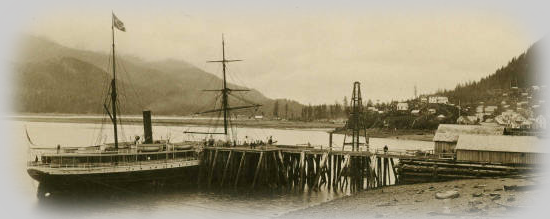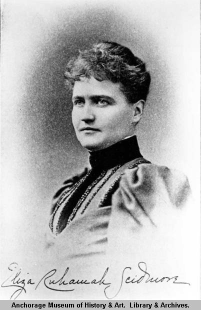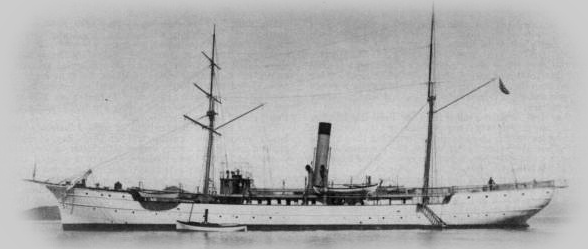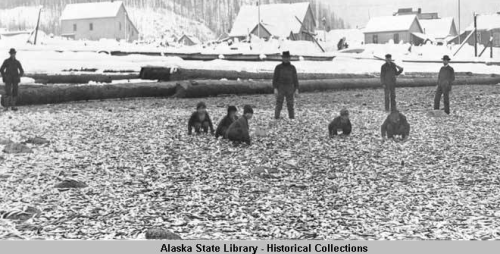Early Written Observations of Herring Abundance

The IDAHO at Carroll's wharf, near South Franklin Street 1887 (Juneau). Coastal steamers like the Idaho began bringing tourists to Alaska in the 1880s.
(William H. Partridge Collection, ASL-PCA-88-062, Alaska State Library--click to enlarge and consult from source)
----WARNING: "Beta" Draft Status This page is still under development!!
---Text may be somewhat readable but is not yet complete---
Nineteenth century writers often remarked on the abundance of herring in Southeast Alaska. Of all the possibilities among the grandeur of the newly-acuired Territy to comment on, these early visitors, tourists, immigrants, and scientists quite often included the small herring in their observations. It is quite likely that observations of extreme abundance are referring to the peaks of strong year classes which pass through herring populations, typically on a somewhat less than decadal scale, rather than the "average" abundance. Still, these written observations describe a remarkable abundance of herring.
Chatham Strait/Killisnoo Area
 Eliza Ruhamah Scidmore wrote what would become the first tourist guidebook to Southeast Alaska, making her first cruises to
Alaska aboard the Pacific Coast Steamship propeller steamer Idaho (1883) and sidewheeler Ancon (1884).
Scidmore was a pioneering travel writer (and later a National Geographic board member, who editor Charles McCarry calls
"the best author the magazine ever had"). On the 1883 voyage, the Idaho accomplished the first exploration of Glacier Bay by a large European-style vessel.
On at least one of the voyages (both voyages are combined in her writings) the coastal steamers
called at Angoon and Killisnoo. Scidmore (1885) paints a descriptive snapshot view of Killisnoo at the moment of her visit(s):
Eliza Ruhamah Scidmore wrote what would become the first tourist guidebook to Southeast Alaska, making her first cruises to
Alaska aboard the Pacific Coast Steamship propeller steamer Idaho (1883) and sidewheeler Ancon (1884).
Scidmore was a pioneering travel writer (and later a National Geographic board member, who editor Charles McCarry calls
"the best author the magazine ever had"). On the 1883 voyage, the Idaho accomplished the first exploration of Glacier Bay by a large European-style vessel.
On at least one of the voyages (both voyages are combined in her writings) the coastal steamers
called at Angoon and Killisnoo. Scidmore (1885) paints a descriptive snapshot view of Killisnoo at the moment of her visit(s):
From the end of August into January the waters of Chatham Strait are black with herring. The Indians used to catch them with primitive rakes, made by driving nails through the end of a piece of board, and with this rude implement they could quickly fill a canoe with herring, each nail catching two and three fish. Seines have supplanted the aborigine's hand rake, and a thousand barrels of silver herring have been taken at a single haul, although the average haul is about half as many barrels, and requiring eleven men to each net then.
Almost a decade later, Scidmore revises and republishes her guidebook, after at least one additional cruise(1891) to Alaska. In this "Appleton's Guide-book", Scidmore (1893) records one enormous school of herring:
The factory's crews net from 300 to 600 barrels of herring at a single haul. Often 1,000 barrels are seined at once, and 1,600 barrels were recently taken by one cast of the seine in Sitka harbour. From September to May, all these waters are visited by great schools of herrings, and once in August the mail steamer passed through one school for four hours, the water silvered as far as could be seen, many whales and flocks of gulls attracted by this run of plenty.
By the 1890s "tourist steamers" are heading to Alaska, exploring Glacier Bay. Aboard one of the steamers, Arthur Inkersley (1895) writes in The American Amateur Photographer, about Killisnoo:
The waters of the neighboring inlet abound in herring which are taken from the middle of August to the end of December....

The U.S. Fish Commission's Albatross was transferred to the Pacific coast in 1888, and made subsequently made numerous voyages to Alaska. Journals of scientists aboard the Albatross provide an introductory glimpse of fish resources, including herring, of the late 19th and early 20th century.
(photograph in public domain--click to enlarge and consult from source)
Moser (1899), recorded observations on the fisheries of Alaska during the first(?) cruise of the U.S. Fish Commission research steamer Alabatross through the inside waters in the summer of 1898. In his report about Killisnoo, Moser (1899) writes:
The herring of Southeast Alaska are small, but in season are rich in oil and of delicious flavor. They are found in many localities running in immense schools, sometimes in smaller numbers, in fact almost disappearing where formerly they were abundant, and appearing in localities not visited before, only to return after several years to their former feeding grounds (p.123)......For many years the inlet at Kootznahoo has been the favorite resort for herring, though lately they seem less abundant. They are found in great numbers on the northern shore of Kuiu Island and at times many are taken in the vicinity of Juneau. The steamer Dolphin cruises through all the interior waters and makes a catch wherever herring are found.
Cobb (1906) borrows some of Moser's (1899) text, but adds some new observations about herring:
They are rather erratic in their movements, however, being in one place especially abundant one year and totally absent the next, possibly returning again after several seasons in greater numbers than before. In southeast Alaska the herring arrive in April for the purpose of breeding, and deposit their eggs in countless numbers in the sea grass and rockweed near shore and on boughs of trees along the beaches near low-water mark. For many years the inlet at Kootznahoo, on Chatham Strait, was the favorite resort for herring, but they ar much less abundant now, owing, it is claimed, to the constant fishing for them with purse seines, which breaks up the schools and drives them away.
Gastineau Channel

Herring catch, Douglas City, Alaska. 1895.
(Alaska State Library, Winter and Pond Collection, ASL-PCA-87-1473.
--click to enlarge from source)
Evermann (1913) in his annual report on Alaska's Fisheries observes:
In Alaska it is said by some that herring are no longer as numerous as they were a decade ago, and the absence of large runs from Gastineaux Channel is cited in support of this contention. Undoubtedly it is true that Gastineaux Channel has shown but comparatively limited numbers of herring during the last few years, but this is not heard with reference to Auk Bay or other near-by waters well known for herring. It may be reasoned that the cycle theory--the periodic preference shown by fish for certain waters--is the chief cause of the present conditions in Gastineaux Channel. It is said by an old-time resident of the region that from 1885 to 1890 there were almost no herring in Gastineaux Channel, while for a few years thereafter the runs were moderately good, and in 1901 and 1902 they appeared in large numbers. Since that time an occasional school has been seen. It should be noted that at no time has this body of water been recognized as a regular heavy producer of herring.
Cobb (1906) writing in his report on the commercial fisheries of Alaska in 1905:
The norther shore of Kuui Island and Gastineau Channel are also favorite spots, although the fish have been rather scarce in the latter place the last two seasons.
Herring Subsistence References
Scidmore (1893):The natives rake them from the water with a bit of lath set with nails, and a family can fill a canoe in an hour. Spruce branches are laid in shallow water along the shore and the herring roe deposited on them are stored in cakes for winter use.Barton Warren Evermann, Chief of Alaska Fisheries Service, notes the take of herring spawn-on-kelp in the Juneau area, albeit filtered through the racial overtones of the era (Evermann 1913):
In this connection, citation is made of the doubtful practice of the Indians at Auk Bay and other places of putting brush in the water each spring during the spawning season for the purpose of securing herring eggs which they dry and make use of as a food delicacy. The adhesive tendency of herring eggs makes it an easy matter to thus secure large quantities with but comparatively little effort. Countless millions of eggs are in this manner destroyed by the Indians. It is doubtful whether this practice of the Indians should longer be permitted.
General Notes on Early Writers
Eliza Ruhamah Scidmore, writing a portion of the Southeast Alaska report for the Census of 1890 (U.S. Dept. of Interior 1893) observes that from the first excursion party led by General Nelson A. Miles in 1882, some 10,000 tourists made their way to Alaska by 1890 (no doubt encouraged by her articles and book)
Back to: History of Southeast Alaska Herring Fisheries
Link to: References
Caution: These pages contain preliminary research results, and are presented here only to further collaborative research and analysis. The information presented has not been fully analyzed or verified for correctness. Please consult the original literature citations for authentic interpretations or contact the author regarding applications of any analysis presented on these pages.
For more information, contact Fritz Funk:
fritz funk.io
| Last modified: Apr 12, 2008 at 21:14:42
funk.io
| Last modified: Apr 12, 2008 at 21:14:42

